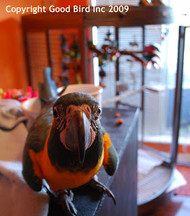When A Parrot Does Not Want To Go Back In Their Cage
Posted by Parrot Cage, Parrot Behaviour, Parrot Training on 7/4/2025
Barbara Heidenreich explains what to do if a Parrot doesn?t want to go back in their cage.
Jackson
Having a baby Blue Throated Macaw (Jackson) and baby Double Yellow Headed Amazon (Joker) Parrot in the house is fun. And apparently it is fun for them too. I like to think so as my house has a number of very entertaining play areas for Parrots. There is this super cool play stand, perches all around the house, and two training areas loaded with all sorts of toys and treats. You can buy play stands here, toys here and treats here.

So when the sun rises, the birds are ready to stretch their wings, participate in some training and play, play, play. This makes for a great morning for the birds, but at some point they do need to return to their cage for a little down time for everyone. This can be a challenge when being outside of the cage is such a blast. Why go back inside if all the fun happens outside?
When I felt one of the birds leaning back on my hand when I approached the cage one morning, I knew it was time to take action. If I forced the bird into the cage, I pretty much knew I was asking for trouble. What would happen is, in the future the birds would be even more hesitant to go back inside.
Training session
Instead we had a training session right then and there. As soon as I felt the lean, I stopped in my tracks and took a step back from the cage. When Jackson?s body language relaxed I gave him some head scratches for sitting calmly on my hand while we were close to the cage. Over time we were able to get closer and he even stepped on a perch in the cage for a treat. I then let him step right back on my hand and come back out.
We repeated this until he was back to stepping into the cage easily. He learned going in the cage doesn?t mean all the fun stops. I now also rotate different toys into the cage. So that every time he goes back there is a new toy to play with. This helps keep this behaviour strong.
Because this behaviour can be challenging, I know I will always be careful to look for body language that says the bird is uncomfortable. And if I see it I will slow down and go through these steps again. This will be important to helping to maintain that behaviour for the long haul. For now I?m also going to be sure to give myself plenty of time to return the birds to their cages, just in case I see any hesitation. I don?t want to have a set back by not planning ahead.
Buy cages here.
Contact details
Barbara Heidenreich
This was originally publishedon Barbara?s blog in 2009.
For more information on training and behaviour please click here.

